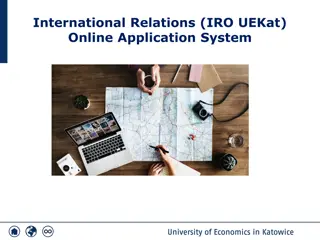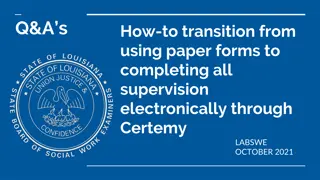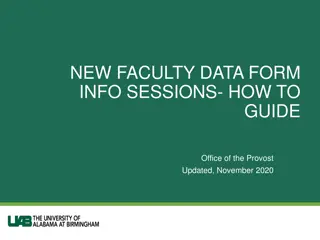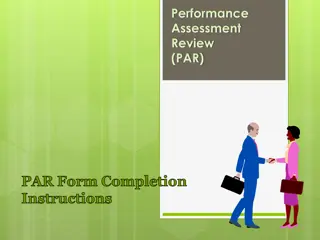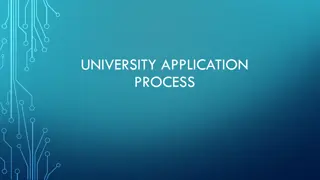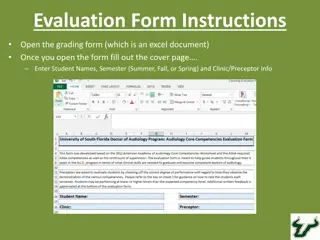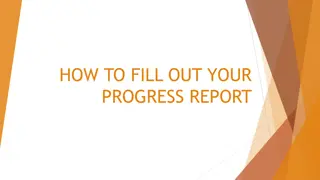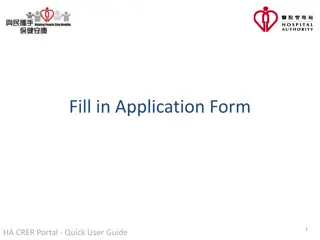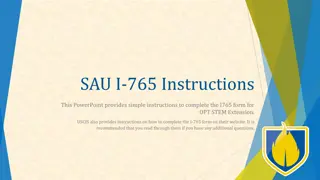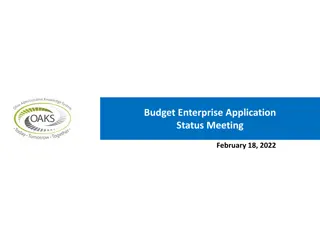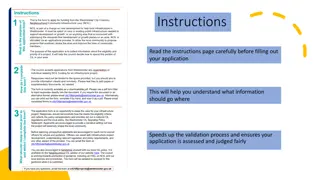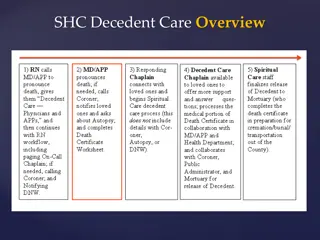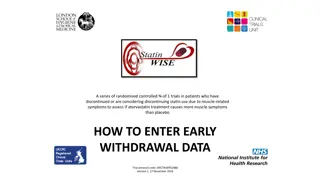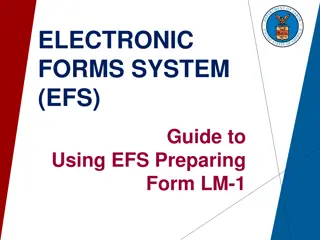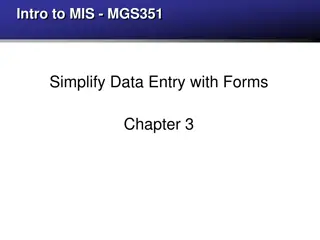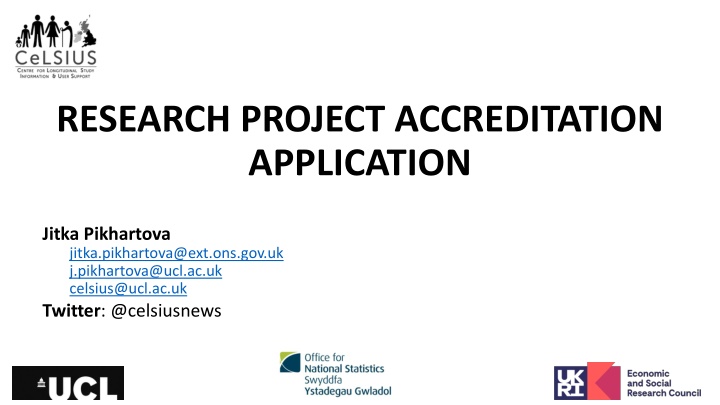
Research Project Accreditation Application Guide
This comprehensive guide provides step-by-step instructions for filling out a research project accreditation application. Covering topics such as application types, project titles, research themes, and abstracts, this resource will help researchers navigate the accreditation process effectively.
Download Presentation

Please find below an Image/Link to download the presentation.
The content on the website is provided AS IS for your information and personal use only. It may not be sold, licensed, or shared on other websites without obtaining consent from the author. If you encounter any issues during the download, it is possible that the publisher has removed the file from their server.
You are allowed to download the files provided on this website for personal or commercial use, subject to the condition that they are used lawfully. All files are the property of their respective owners.
The content on the website is provided AS IS for your information and personal use only. It may not be sold, licensed, or shared on other websites without obtaining consent from the author.
E N D
Presentation Transcript
RESEARCH PROJECT ACCREDITATION APPLICATION Jitka Pikhartova jitka.pikhartova@ext.ons.gov.uk j.pikhartova@ucl.ac.uk celsius@ucl.ac.uk Twitter: @celsiusnews
On CeLSIUS web page: https://www.ucl.ac.uk/epidemi ology-health- care/research/epidemiology- and-public- health/research/health-and- social-surveys-research- group/studies-54
Document has 12 pages ; quite straightforward to fill in.JUST read the task well and answer what is wanted because in some parts, there is a WORD LIMIT
1. About the project 1. About the project 1a) Application type There are two types of project application you can choose from. Full project Exploratory analysis ! if your exploratory analysis application is approved, you will not be able to take any findings out of the Accredited Processor safe setting or publish your research 1b) Project title and duration Self-explanatory part 1c) Research theme Select the theme that most closely matches the subject of your research project. If your project theme is not included below, select Other theme and specify it in the second box.
1. About the project 1. About the project 1d) Abstract This should be a short description of your research project and the public good it will provide (i.e. a summary of the purpose, methodology, public good and predicted publication). ! ! It will be published on the UK Statistics Authority website and the CeLSIUS website and will help other researchers quickly identify your project
EXAMPLE of Abstracts: This research will provide a description of ..in England and Wales (E&W), and its causes and consequences. Using data from the ONS-LS, including data from the 2021 Census, we will examine those born in specific cohort and how their .changed compared to previous cohorts. We will correlate measures for parents and their children, using standard regression modelling, disaggregating our results by gender, ethnicity and region. By producing the most up-to-date picture . in E&W, this research provides a robust evidence-base for policy. Findings will be disseminated via working papers and journal articles.
1. About the project 1. About the project 1e) Research purpose provide a more detailed description of your project s aim and objectives include clearly defined hypotheses to test or research questions to be answered include whether this research is part of a larger body or programme of work. the information will help ONS to assess whether your proposal will be feasible, appropriate and clearly beneficial to the public.
EXAMPLE of Research purpose The primary contribution of the research will be to produce robust estimates .. and to compare this to previous generations. We will also be studying The proposed research builds on and extends . in England and Wales using the ONS-LS for the period . Mentioned research produced important contributions to our understanding of , shedding new light on trends in for men and women between (REF), how these trends varied across ..(REF), and how . was affected by policy reforms (REF). This research is funded by ., and continues a longstanding research agenda funded by . Using the ONS Longitudinal Study (ONS LS), this research will provide the most up-to-date and comprehensive answers to this question, as well as interrogating the underlying causes and consequences of changing patterns of . We will address the following research questions (RQ RQs): 1. 2. 3. . We will disseminate our findings through The ONS-LS is a secure dataset that has high barriers to access, and derivation of .estimates requires significant coding time and expertise.
1. About the project 1. About the project 1f) Project methods i i) ) Select all methods you will be using for your project i ii) i) Please explain how the methods selected will lead to valid conclusions and the extent to which this method will ensure the project provides the public benefit/s of the project
Example of Project methods The methods outlined below are conventional statistical methods (e.g., linear regression), and we will explore the feasibility of these analyses in previous work using the ONS-LS. This provides confidence that the proposed methods will indeed realise public benefits of the research. Below we outline the proposed methods and rationale for each research question (RQ) RQ1: We will use standard linear regression and logistic regression to estimate the correlations between parent and child socio-economic status. We will explore multiple measures of socio-economic status, to offer a complete picture of RQ2: For this research question we will use standard linear and logistic regression modelling, as well as descriptive analysis (cross-tabulations) to explore the . trajectories over the lifecycle. Now we will have data spanning 1971 to the 2021 Census, which afford additional observation points over the lifecycle. This will allow us to examine the patterns of . for women in more detail, for example, RQ3: .
1. About the project 1. About the project 1f) Project methods iii) iii) Are there any potential biases or Are there any potential biases or limitations within the methodology? limitations within the methodology? You must give the assurance that you have thought about the limitations of the methods, any identified biases and how they might research, and that you have plans in place to mitigate against any risks identified. impact on your iv) iv) Project commissioner/ funder Project commissioner/ funder Self-explanatory
Example of Potential biases The primary aim of this research is to produce robust estimates of intergenerational correlations of economic and social status, both nationally and for subgroups of interest. We are not concerned with obtaining causal estimates, thereby residual confounding is not an issue. They key potential methodological issues are those of measurement. In particular, sample size and issues of which timepoints in the lifecycle to use. We have explored these issues in previous work and have established the feasibility of the proposed methods, and devised suitable robustness checks where necessary (for example, studying multiple points across the lifecycle). These issues will in fact be mitigated with the addition of the 2021 Census, as we will have a larger sample size and more points in the lifecycle. Where sample sizes become an issue, such as with certain local authority districts, we will aggregate areas over time, or across space, to ensure that minimum sample sizes for robust estimation are maintained. In general, we expect all LAD estimation to have at least 50 observations.
2. Project team 2. Project team a) Project lead b) Project deputy lead c) Additional team members -Self-explanatory
3. Data requirements 3. Data requirements a) Data required This will be the ONS Longitudinal Study. e.g. 1971, 1981 NB: If you want access to other datasets that are available through the SRS (e.g. Understanding Society (UKHLS)) you will need to submit a separate Research Project Accreditation application for those datasets. b) External datasets
Example If YES in 3b): We would like to merge in .. as described in the below text. We will also seek to identify other relevant external variables, which we would seek to gain relevant approval to ingest in due course. Examples may include population statistics from the NOMIS website (https://www.nomisweb.co.uk/), and school quality information from the https://www.get- information-schools.service.gov.uk/ website. ************ You can also add : You can also add : Summary of purposes why you need to merge named datasets, what other quality it can bring What derivations/ aggregations you plan Technical details of coding Public benefit of those added data
3. Data requirements 3. Data requirements c) Use of unpublished data d) Data linking source e) Data sources f) Data access duration g) Software required -self explanatory
Examples 3d) Data linking source 3c) Use of unpublished data We occupation (SOC code) and basic demographic characteristics (sex and region) as outlined in the previous section. will merge in average earnings by We have considered using ..however they are not fit for purpose because .. A key advantage of the ONS-LS for .. research is that the census records for all co-resident household members can be linked to ONS-LS main study members for each census year. We also plan to identify and merge in further relevant area-level characteristics at the LAD level, and relevant approval will be sought at that time. Examples may include labour market and population statistics from the NOMIS website (https://www.nomisweb.co.uk/), and school quality information https://www.get-information- schools.service.gov.uk/ website. Another advantage is .. from the
4. Ethics 4. Ethics All DEA Accredited Research project applications must include appropriate ethics scrutiny before they can be accredited. We suggest that you complete the Ethics self-assessment sheet (covered in final presentation today) 5. Public benefits 5. Public benefits a) Public benefits To get approval for your project application, you must show that it will provide a clear public good to the UK. Indicate all the benefits that apply. Your Your project project should should deliver deliver at at least public publicbenefits benefits in in the the table table provided least one provided. . one of of the the b) Risks to public good Self-explanatory
6. Publication 6. Publication ONS is unlikely to decide that your project will deliver public good if the findings are not made public. a) Do you intend to publish your findings? b) What research outputs do you intend to produce to make your research available to the public? c) How will your research outputs be disseminated. d) What is your best estimate of when you expect to publish your results? e) Describe the circumstances that mean you need an exemption from making your results available to the public. f) Would you be willing to work with ONS to showcase the impact of your research findings?
Once completed, please return this application form with the Longitudinal Study Supplementary Form the Longitudinal Study Supplementary Form and the Self Self- -assessment form assessment form by email to: celsius@ucl.ac.uk celsius@ucl.ac.uk


